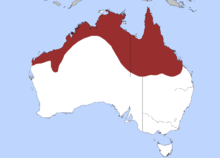Post by Ceratodromeus on May 13, 2015 1:23:03 GMT 5

Scientific classification
Kingdom: Animalia
Phylum: Chordata
Subphylum: Vertebrata
Class: Reptilia
Order: Squamata
Suborder: Serpentes
Family: Pythonidae
Genus: Aspidites
Species: Aspidites melanocephalus
Description: The black headed python is easily distinguished from other Australian pythons via its characteristic black head -- which of course gives the snake its common name. It has a coloration resembling that of the closely related woma python, and is often confused with it by the casual observer. Males average a length of 5.1ft SVL, while the females average 5.2ft in SVL.{1} Large indviduals can measure out to 7.1ft and weigh as much as 10lbs, but typically they are much smaller then this. Unlike pythons elsewhere, The black headed python lacks the heat-recepting pits that are commonly seen in pythons else where; the same can be said for the only other representative of the Aspidites genus, A. ramsayi.
Range: These snakes are found in the northernmost deserts Of Australia, though they do not tend to venture into the very arid areas.

Dietary habits: This snake specializes in eating other members of Reptilia.As much as 90% of their diet consists of small lizards (lacertids, agamids) and snakes. Noted prey items include (but are not limited to) Sand monitors(V. gouldii) Black headed monitors (V. tristis) Bearded dragons (Pogona) Blue tongued skinks (Tiliqua sincoides) Desert skinks (Egernia) and king brown snakes (Pseudechis australis){1}
Reproduction: Mating occurs in March - May, with the eggs being layed 2 to 3 months later. Clutch size varies between 2- 8 eggs, depending on the size and age of the female. When theyoung hatch, they measure between 21-23in(53-58cm ) and weigh roughly 76-83g.{2} Their coloration resembles that of the adult animals. When they hatch the young must becautious; These snakes are known to be cannibalistic as soon as they come out of the egg.
References
{1}Shine, Richard, and David J. Slip. "Biological aspects of the adaptive radiation of Australasian pythons (Serpentes: Boidae)." Herpetologica (1990): 283-290.
{2}Murphy, James B., William E. Lamoreaux, and David G. Barker. "Miscellaneous notes on the reproductive biology of reptiles. 4. Eight species of the family Boidae, genera Acrantophis, Aspidites, Candoia, Liasis and Python." Transactions of the Kansas Academy of Science (1903) (1981): 39-49.


